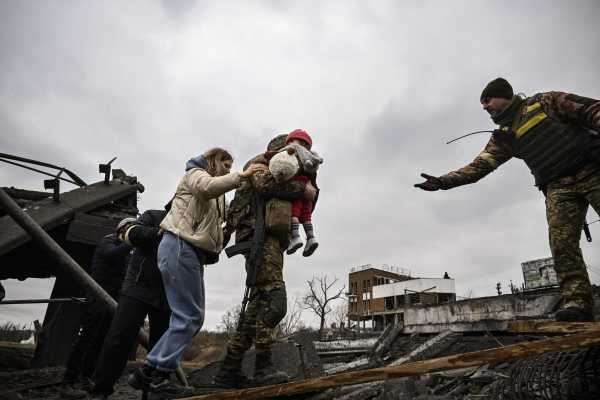
The Russian assault on Ukraine is ongoing, with Russian forces moving on major population centers including Mariupol in the southeast and the capitol, Kyiv. As the war moves into major cities, Russia has started to deploy brutal siege tactics — like using cluster munitions and bombing civilian infrastructure — which its military previously utilized in conflicts in Syria and Chechnya.
Such tactics could be a prelude to costly street-to-street fighting as Russia attempts to take Ukraine’s major cities, though tactical blunders on the ground, particularly outside of Kyiv, have in some cases stalled Russian ground advances.
Ukrainian armed forces, combined with the Territorial Defense Forces protecting individual cities and a civilian population armed with rifles and determined to resist occupation, have thus far had unexpected success in fending off Russian assaults. Western efforts to arm, train, and fund the Ukrainian military, too, have given it the capacity to punch far above its weight — something the Russian government, in an effort to downplay the seriousness and scale of the invasion, didn’t deploy forces to counter, Mason Clark, the lead Russia analyst at the Institute for the Study of War, told Vox last week.
But that’s changed in recent days: Russian ground troops are still stalled outside Kyiv, but they have managed to make significant headway in Kharkiv and Mariupol, in addition to capturing the largest nuclear power plant in Europe, the Zaporizhzhia facility, on Friday. Russian forces are also attempting to move on Odessa, another port city in the southwest.
According to Rita Konaev, the associate director of analysis at Georgetown University’s Center for Security and Emerging Technology, Russia’s evolving military tactics underscore a new direction for the conflict.
“The Russian approach to urban warfare very much emphasizes priming and prepping the ground for any sort of ground operation with this destruction from the air. It’s to break morale, it’s to cause significant damage to the infrastructure of cities, it’s to cause high levels of displacement from the cities,” Konaev told Vox. “That air campaign is an integrated and important part of the way that Russia sees warfare.”
Russia is deploying devastating siege tactics against Ukrainian cities
Analysts say Russia is currently preparing the ground in Ukraine’s cities by trying to raze as much infrastructure as possible by air in order to make the ground assault easier.
“The key thing that we’ve been watching in the last 72 hours is, they’ve been starting to directly shell major cities, primarily Kharkiv, but we’re now seeing it in Mariupol as well, that they refrained from doing in the early days of the war,” Clark told Vox in an interview Thursday.
Kharkiv is Ukraine’s second-largest city and has already seen heavy fighting, including rocket attacks resulting in civilian casualties.
Now, according to Clark, those attacks are likely to be stepped up from the early days of the conflict, when Russia “likely did not use these higher-scale artillery fires and airstrikes and those sorts of assets because they expected a quick victory” — which hasn’t occurred — “and didn’t want the portrayal in international and domestic Russian media of destroying Ukrainian cities.”
In a small village near Kharkiv, which is close to Ukraine’s eastern border with Russia, civilians have been caught up in intense shelling, Al Jazeera reported Friday. The most recent attacks reportedly killed three civilians. Although the city of Kharkiv is still under Ukrainian control, it’s been under heavy and indiscriminate shelling since the beginning of the war, with significant escalation starting February 28, according to a report by the Digital Forensic Research Labs’s Michael Sheldon, published by Atlantic Council. That report found that Russia had used BM-30 300mm multiple launch rocket systems (MLRS), which can launch cluster munitions — essentially bombs containing smaller munitions, which can cause extreme devastation when used in civilian areas.
“Cluster munitions have a relatively high failure rate, meaning that a bunch of them don’t explode, they don’t detonate [after] impact. So in addition to that initial impact, all of that unexploded ordnance remains, on massive areas where people used to live, and want to continue living, and then they’re basically like landmines,” Konaev said.
In addition to ongoing shelling, Russia is also attempting to cut off resources to key cities. In Mariupol, a city of more than 400,000, water, heat, and electricity have been shut off for days throughout a ferocious Russian bombardment campaign. According to Konaev, urban areas are dependent on a “pretty fragile grid system of life-saving and life-necessity utilities. If you damage one pipe, it can damage water access or heating for thousands of people.” The kind of destruction Russia is unleashing, therefore, could affect millions as the war continues.
“It will be devastating,” Konaev said, “because it’s going to depend on whether they’re going to still allow that humanitarian corridor where people are allowed to leave, and how are they going to be treating those movements?”
Thus far, humanitarian ceasefires to allow evacuations haven’t been successful, despite an ostensible agreement between Russia and Ukraine; Mariupol and the city of Volnovakha halted evacuations on Saturday as Russian attacks on civilian targets resumed, the Wall Street Journal’s Yaroslav Trofimov reported.
“These will be real sieges,” a US official told the Washington Post’s Paul Sonne and Ellen Nakashima Friday. “They will be almost medieval in their approach. They will cordon cities. They will bombard them until the ground bounces. And then they will go in, and they’ll go street to street.”
The Russian military has used these same strategies in Syria and Chechnya
Past conflicts paint an alarming picture of where Russia’s siege tactics could be headed, experts told Vox. Though it’s unclear how far Russia might go in Ukraine, the most extreme version of such tactics can result in mass civilian casualties.
“In Syria, Russia’s predominant role was as part of the air campaign, so an air bombardment that just targeted cities, that’s where you saw the [extensive use of] cluster munitions,” Konaev told Vox. “Most of the heavy lifting that the Russians did was concentrated on aerial bombardment,” which decimated parts of Aleppo and other Syrian cities.
“They used everything they could in Aleppo, and as much as I don’t want to see this, I wouldn’t be surprised if they started using the same planes, bombs and missiles to target civilians in Ukraine,” Mustafa al-Qaseem, a Syrian refugee from Aleppo who settled in Germany, told Al Jazeera.
Syria isn’t the only parallel; in the first Chechen War, in 1994 and 1995, Russian forces attacked the Chechen capitol, Grozny, flattening it with aerial bombardments before withdrawing in 1997. Then, in December 1999, Russia went back and destroyed what remained, until Grozny was so decimated that the UN declared it the most destroyed city on Earth.
In both Syria and Chechnya, the Russian military was able to hone the devastating — and possibly illegal — tactics it is now beginning to deploy in Ukraine.
“Health workers were targeted, medical facilities were bombed, there have been confirmed reports where doctors and humanitarian convoys did not want to have their location be shared during the deconfliction process [in Syria],” Sahr Muhammedally, the director for the MENA region and South Asia at the Center for Civilians in Conflict, told Vox. ”Russia bombed these facilities, even knowing that these were hospitals.”
Hospitals and ambulances have reportedly been hit in Ukraine, too; US Secretary of State Antony Blinken condemned Russia for the attacks on Tuesday, while advocating for the Russian Federation to be removed from the UN Security Council. US officials have so far declined to say that Russia is deliberately targeting civilian infrastructure, but the lack of discernment by Russia in the war so far is having brutal effects.
“It is really horrific to see this, this intentional targeting of civilians to submit them, to get them to give up,” Muhammedally told Vox. “We saw this in Homs, we saw this in Aleppo, and even neighborhoods were bombed, markets were hit.”
Now, Ukrainian cities could be facing the same kind of destruction.
The future of the Ukrainian war includes much more devastation
Ukrainians aren’t fighting like they intend to give up any time soon — which will almost inevitably lead to further destruction as the fight shifts to ground warfare.
“We tend to think about urban warfare as this door-to-door, building by building, street by street fight, which is a predominantly ground battle, reliant on infantry and artillery, which is correct,” Konaev said. “But it’s also a multi-domain battle that involves this air bombardment element, especially for Russia.”
Some analysts, Konaev included, have pointed to the battle for Mosul in 2017 as an indicator of the brutal morass that such urban ground assaults can become.
While there are obvious differences — among other things, Ukraine is a sovereign country fighting against an unprovoked invasion, rather than a brutal terrorist group — there are also some parallels with the nine-month-long battle for Mosul.
“It took nine months because ISIS was well-trained, well supplied, and very dedicated to its cause,” Konaev said — a situation reflected by the Ukrainian armed forces and civilian resistance. What’s more, she said, defenders have an unquestioned advantage in urban fighting, and it will be more challenging for the invading force to hold a city, in part because they lack intimate knowledge of the area.
“You have the power but you have to fight smart,” John Spencer, the chair of Urban Warfare Studies at West Point’s Modern War Institute, tweeted last month in a thread explaining his advice to the Ukrainian resistance. “The urban defense is hell for any soldier. It usually take 5 attackers to 1 defender. Russians do not have the numbers.”
As Russia’s siege tactics indicate, though, Putin is intent on taking Ukraine’s cities — and whether or not he succeeds, history suggests the next phase of the war could cause even more civilian casualties.
Will you support Vox’s explanatory journalism?
Millions turn to Vox to understand what’s happening in the news. Our mission has never been more vital than it is in this moment: to empower through understanding. Financial contributions from our readers are a critical part of supporting our resource-intensive work and help us keep our journalism free for all. Please consider making a contribution to Vox today.
Sourse: vox.com






